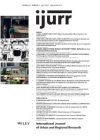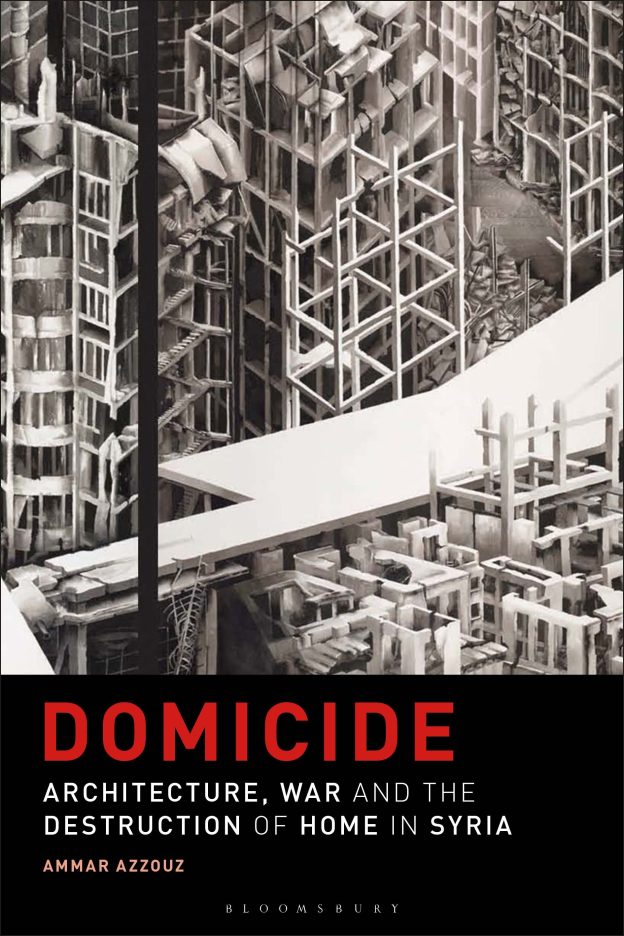According to the latest monthly report from UNOSAT (the United Nations Satellite Centre), beyond causing a staggering loss of civilian life, since October 2023 Israel’s aerial and ground offensive in the Gaza Strip has turned more than half of its built structures to rubble. Urbicide, a term popularized by scholars during the Bosnian war (1992–1995), has become a useful shorthand for those trying to articulate the deliberate and systematic destruction of cities and civilian infrastructure during conflict. The book currently under review focuses on its cognate term, domicide.
In Domicide: Architecture, War and the Destruction of Home in Syria, Ammar Azzouz, a British-Syrian architect and scholar, delves into the deliberate destruction of homes as a strategic tool of war in Syria. He offers the reader a powerful exploration of how such intentional destruction has affected Syrian homes since 2011, with devastating consequences on both a material and symbolic level. As Azzouz shows throughout the book, the concept of domicide aptly encapsulates the manifold forms of devastation that go beyond the mere physical destruction of residential buildings; it captures the wilful erasure of memory, identity and the very essence of what it means to dwell and belong.
The book’s main concern is to illuminate the ways in which architecture and urban planning have been weaponized in Syria, with clear echoes from and relevance to other conflicts further afield (Mosul, Mariupol, Gaza). Azzouz shows the reader that the destruction of homes is not just a by-product of war but a deliberate act of violence aimed at uprooting communities and erasing local solidarities and communal identities. This form of destruction births a new form of suffering; one that needs to be recognized for the way in which it violently severs important affective ties between communities and their sense of belonging. A belonging which is always emplaced, until it becomes forcefully displaced.
One of the key strengths of Azzouz’s work is his ability to flesh out the lived aspects of theoretical concepts like urbicide and domicide. Drawing from his own knowledge and experience as a native of Homs, a city that has seen tremendous devastation since Syria’s civil war began in 2011, Azzouz’s writing reminds us that behind every pulverized brick, demolished corner shop or obliterated rooftop, there are countless human stories. By anchoring his exploration in the stories of those affected by the war, the book offers a grounded critique of the often-overlooked role that architecture plays in both the destruction and potential reconstruction of cities at the heart of conflict.
Chapters 3 and 4 accomplish this by looking beyond physical destruction to include the obliteration of a city’s social fabric, which is painstakingly kept alive through collective memory and artistic practices by those in exile. Azzouz thus offers a nuanced perspective that challenges traditional architectural discourse—a discourse which often focuses on buildings as static objects rather than as spaces intertwined with human experience. These chapters draw attention to the way architecture and the experience of its loss can play an unexpected role when it comes to reconstructing lives in exile, or cities back in Syria.
At the same time, Azzouz’s scholarship stands out for its methodological suppleness. Displaced himself by the conflict and unable to conduct research in Syria, the book is based on a range of materials. Bringing together visual materials—videos and newspaper articles, city council webpages, the social media accounts of various charities providing extensive interviews with Syrians both inside and outside the country—Azzouz takes the reader through the various scales at which the devastating loss of home is articulated in the Syrian case.
A welcome inclusion is the particular attention he pays to those who have become ‘architects’ by necessity as they rebuild their homes amid ruins. This ethnographic attention to people’s interactions and affective experiences moves the writing beyond theoretical exploration into a documentation of lived experiences. In this way, Azzouz’s methodological approach bridges the gap between abstract architectural theory and the everyday realities of people affected by war, making the book an important and also accessible resource for scholars interested in the intersection of architecture, politics and human rights.
The final chapter stands out by challenging the reader to think about the future of cities destroyed by war. In the aftermath of violent conflict, it has been known for reconstruction efforts to be hijacked by powerful financial and political interests, with Beirut’s downtown being just one such cautionary tale in the region. Azzouz calls for reconstruction efforts that prioritize the needs and traditions of the local communities rather than the imposition of external—occasionally culturally tone-deaf—solutions. For example, he rightly identifies the problematic ways in which concern for heritage has a tendency to be mobilized to the detriment of local communities and their immediate socio-economic needs.
As such, the book contributes to ongoing debates in post-conflict reconstruction by advocating a reconstruction process that is sensitive to the needs and desires of local communities. Azzouz aptly identifies and critiques the common focus on restoring cultural heritage and monumental architecture, arguing that such efforts often overlook the more immediate needs of displaced populations. The chapter offers a balanced critique of the all-too-common focus on cultural heritage and ancient architecture that is present in rebuilding efforts. Instead, these efforts should prioritize the social fabric and lived experiences of communities, rather than imposing top-down solutions that frequently do not resonate with those most affected by the conflict.
Domicide: Architecture, War and the Destruction of Home in Syria is an essential read for those interested in pressing questions at the intersection of architecture, urban planning, conflict studies and the political economy of the Middle East. It offers grounded insights into how war reshapes not just cities, but the very concept of belonging, and it serves as a call to action for more humane and community-focused reconstruction efforts in the aftermath of conflict. The book is not only a poignant account of the Syrian conflict told through the perspective of space and place, but also a significant scholarly contribution to multiple fields, including architecture, urban studies and post-conflict studies. It will hopefully also challenge architects, urban planners and policymakers to rethink the role of architecture in post-conflict settings and reconsider the importance of prioritizing human needs in the reconstruction of cities that have been turned to rubble by war.
Cristiana Strava, Leiden University
Ammar Azzouz 2023: Domicide: Architecture, War and the Destruction of Home in Syria, London: Bloomsbury. Cover used with permission of Bloomsbury.
Views expressed in this section are independent and do not represent the opinion of the editors.

